Irina Tezaur
Distinguished Member of Technical Staff, Quantitative Modeling & Software Engineering Department
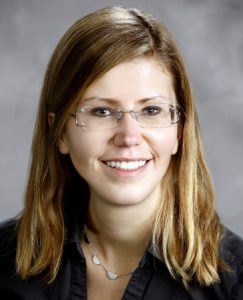
Distinguished Member of Technical Staff, Quantitative Modeling & Software Engineering Department
(925) 294-2474
Sandia National Laboratories, California
P.O. Box 969
Livermore, CA 94551-0969
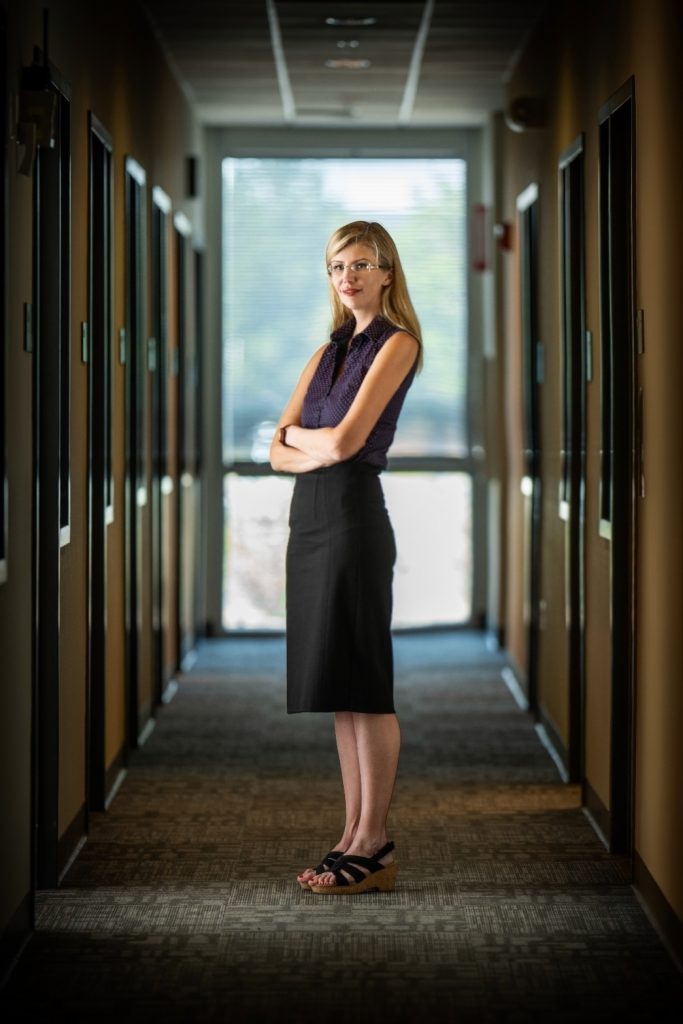
About Me
As of May 2021, I am a Distinguished Member of Technical Staff (DMTS) in the Quantitative Modeling & Software Engineering Department at Sandia National Laboratories in Livermore, CA. From September 2014 to May 2021, I was a Principal Member of Technical Staff (PMTS) in the same department, and from October 2011 to September 2014, I was a Senior Member of Technical Staff (SMTS) in the Computational Mathematics Department at Sandia in Albuquerque, NM. I received my Ph.D. in Computational and Mathematical Enineering (CME) from Stanford University in 2011. My advisor at Stanford was Professor Charbel Farhat and I was a member of the Farhat Research Group (FRG). My Bachelors and Masters degrees are in pure mathematics, awarded by the University of Pennsylvania in 2006. While a Ph.D. student at Stanford, I had the opportunity to work part time and during the summers as a Graduate Technical Intern in Sandia Albuquerque’s Aerosciences Department.
In 2019, I was named one of the recipients of the Presidential Early Career Award for Scientists and Engineers (PECASE) for “developing new, impactful mathematical methods and computer algorithms to enable real-time analysis, control, and decision-making on computationally prohibitive problems relevant to nuclear security mission and climate modeling.” Other honors I have received include winning the Robert J. Melosh medal for the best student paper in finite element analysis in 2008, and, in 2007, being awarded two fellowships which funded my graduate studies, the National Defense Science and Engineering Graduate (NDSEG) fellowship and the National Physical Science Consortium (NPSC) fellowship.
A short bio summarizing my research interests, accomplishments and present work can be found here.
In January 2015, I got married and changed my last name from Kalashnikova to Tezaur. As a consequence, I have publications/presentations under both names.
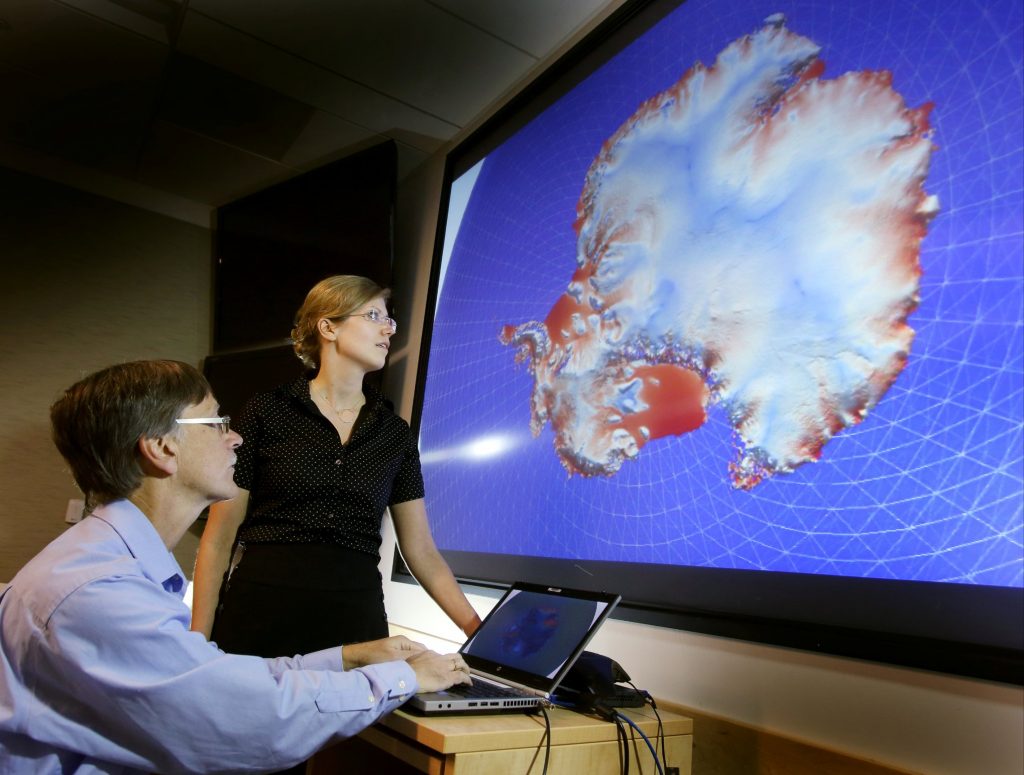
Research Interests
- Numerical solution to PDEs.
- Enriched finite element methods.
- Stability and convergence properties of numerical methods.
- Reduced Order Modeling (ROM).
- Climate modeling.
- Multi-scale coupling methods.
- Performance portability of codes to next-generation architectures.
- Scientific computing/HPC.
- Software engineering.
News
April 15, 2024: As chair of the USACM’s Energy & Earth Systems Technical Thrust Area (TTA), I am pleased to announce our fourth monthly webinar presentation, entitled "Fluid-Structure Interaction Simulations in Wind Energy", given by Prof. Joris Degroote from the University of Gent in Belgium. For those who missed it, a recording of the webinar can be found here.
March 18, 2024: As chair of the USACM’s Energy & Earth Systems Technical Thrust Area (TTA), I am pleased to announce our third monthly webinar presentation, entitled "Data assimilation and optimization frameworks for CO2 storage operations", given by Prof. Lou Durlofsky from Stanford University. For those who missed it, a recording of the webinar can be found here.
February 19, 2024: As chair of the USACM’s Energy & Earth Systems Technical Thrust Area (TTA), I am pleased to announce our second monthly webinar presentation, entitled "Water Sustainability: Satisfying the Thirst of Stakeholders", given by Prof. Lea Jenkins from Clemson University. For those who missed it, a recording of the webinar can be found here.
January 22, 2024: As chair of the USACM’s Energy & Earth Systems Technical Thrust Area (TTA), I am pleased to announce our first monthly webinar presentation, entitled "Modeling Glacier and Ice-shelf Flow and Fracture Processes using Computation, Data, and Machine Learning", given by Prof. Ravindra Duddu from Vanderbilt University. For those who missed it, a recording of the webinar can be found here.
January 13, 2024: I am excited to announce that I will be joining the Editorial Board of the International Journal for Numerical Methods in Engineering for the standard 3 year term.
December 10, 2023: Three Stanford Masters engineering students (Jinny Chung, Peter Krenek and Siqi Ma) I co-mentored as part of a research course they took in Fall 2023 (CME 218: Applied Data Science) created the following very nice video on their work involving the coupling Physics-Informed Neural Networks (PINNs) using the Schwarz alternating method. Please check it out if you are interested in this topic.
November 27, 2023: My teammates and I are honored to have our Innovative HPC Approach for Modeling Arctic Permafrost Degradation and Coastal Erosion be featured in Sandia National Laboratories’ 2023 HPC Annual Report. The report features 12 articles that give an overview of how Sandia is shaping the nation’s computing future and showcases Sandia’s impact in tackling some of the nation’s toughest challenges.
November 6, 2023: Please check out the following pre-print of our manuscript "A Fundamentally New Coupled Approach to Contact Mechanics via the Dirichlet-Neumann Schwarz Alternating Method", co-authored by Alejandro Mota, Daria Koliesnikova, myself and Jonathan Hoy, and recently submitted to IJNME. Rather than introducing contact constraints into the variational form of the problem, as done in conventional contact techniques, the new method treats each body as a separate, non-overlapping domain and prevents interpenetration using an alternating Dirichlet-Neumann iterative process. Numerical experiments demonstrate that the method is more accurate and robust than conventional contact enforcement algorithms, and additionally exhibits exceptional energy conservation properties.
November 5, 2023: I am excited to announce that a Special Issue on Computational Modeling of Ice Sheets and Glaciers of Computing in Science & Engineering (CiSE), which I edited along with Mauro Perego, Matt Hoffman and Josefin Ahlkrona has been published. A special thanks to CiSE Editor-in-Chief Lorena Barba or her support.
November 1, 2023: I am pleased to announce that a pre-print from my intern Will Snyder’s Computer Science Research Institute Summer Proceedings 2023 paper on coupling Physics-Informed Neural Networks (PINNs) with each other and with full order models using the Schwarz alternating method is available on ArXiV at the following link.
September 25, 2023: Please check out our recent paper on a Lagrange multiplier-based method for coupling reduced order models (ROMs) with each other and with full order model following a domain decomposition of the underlying problem geometry. The paper was co-authored with my colleagues Amy de Castro, Paul Kuberry and Pavel Bochev, and is appearing in a special issue of CMAME celebrating Prof. Tom Hughes’ 80th birthday.
August 28, 2023: I am happy to announce that a paper I co-authored with Anthony Gruber entitled "Canonical and noncanonical Hamiltonian operator inference" has been published online in Computer Methods in Applied Mechanics and Engineering, and can be found here.
August 12, 2023: As the Sandia Principal Investigator of the Grande CARES Minority Serving Institution Partnership Project (MSIPP) consortium, I am excited to share the following Sandia Lab News article that has just come out on the consortium and the first batch of student visitors we had at Sandia the past few months.
July 25, 2023: Thank you to all those who attended the kick-off meeting for the new USACM Energy and Earth Systems Technical Thrust Area (TTA) held at USNCCM17 in Albuquerque, NM. Please use the following link to join the TTA, which is free for all USACM members. Please also check out our recently-created LinkedIn page for the TTA.
June 27, 2023: For those interested, our paper entitled "Performance portable ice-sheet modeling with MALI" has been published in the International Journal of High Performance Computing Applications. The paper describes how we attain performance portability of the MALI ice sheet model to heterogeneous architectures (including KNL and GPU) using the Kokkos library. It also describes how we are able to maintain performance of the code using a change point detection-based automated performance testing algorithm.
June 21, 2023: It was an honor to serve as a panelist in a career panel discussion targeting early career scientists and students, held at the SIAM Conference on Mathematical & Computational Issues in the Geosciences 2023. Below is a photo of myself with the other panelists.
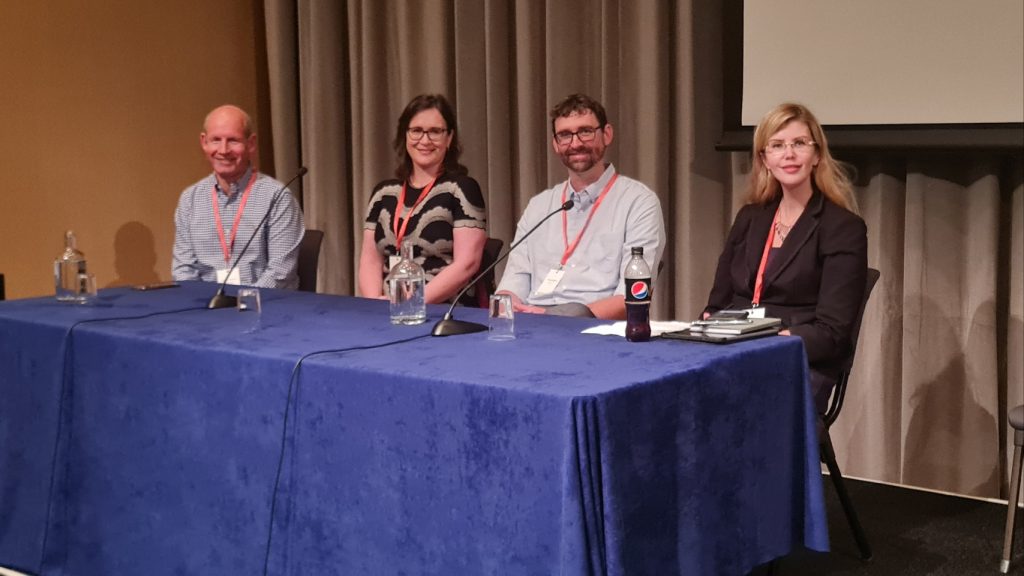
June 16, 2023: I am pleased to announce that our paper entitled "ALEGRA: Finite Element Modeling for Shock Hydrodynamics and MultiPhysics" has been published in the International Journal of Impact Engineering, and can be downloaded here.
June 12, 2023: A pre-print of our paper entitled "Explicit synchronous partitioned scheme for coupled reduced order models based on composite reduced bases" is available here on ArXiv. The paper has been submitted to a special issue of Comput. Meth. Appl. Mech. Engng. honoring Prof. Tom Hughes’ 80th birthday.
May 25, 2023: Please check out Part 1 of a recent special issue of CiSE, entitled "The Future of Research Software Engineers in the U.S.", edited by myself, Jeff Carver, Nasir Eisty, Hai Ah Nam and CiSE editor-in-chief Lorena Barba. Part 2 will appear in the next issue of CiSE.
April 28, 2023: It was a pleasure to participate this past week in the Computational Challenges and Emerging Tools Workshop, which I co-organized at the Isaac Newton Institute in Cambridge, UK as part of a program on The Mathematical and Statistical Foundation of Future Data-Driven Engineering. Below is a group photo from the workshop.
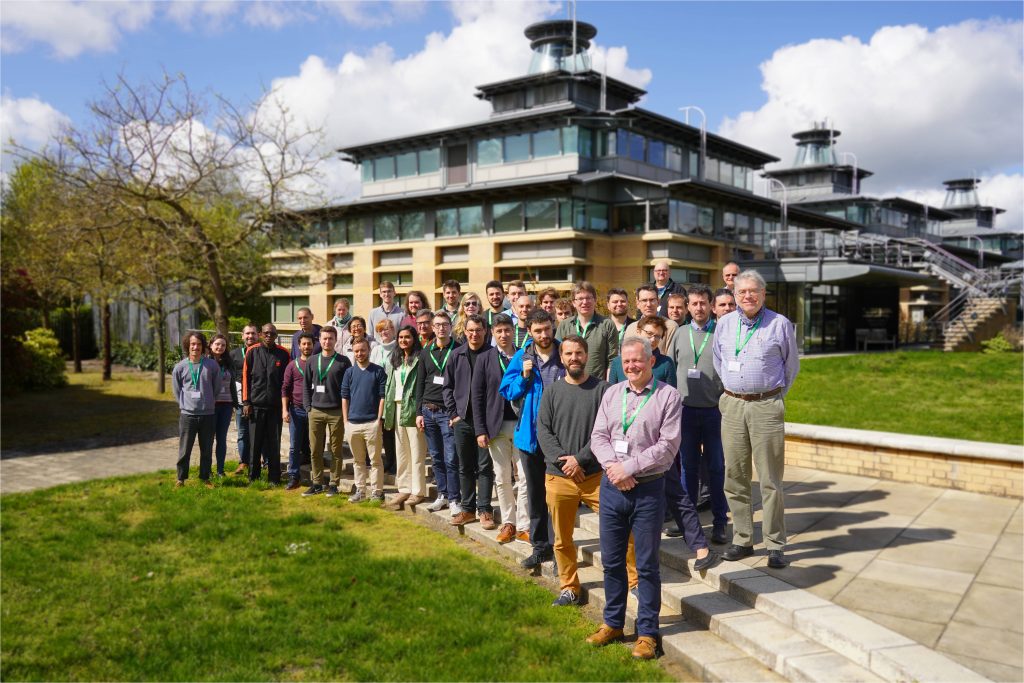
April 18, 2023: My colleague Anthony Gruber and I are excited to announce that we have completed and submitted our paper on Hamiltonian structure preserving reduced offer models constructed ninintrusively using operator inference. A pre-print of the paper is available on ArXiv. The approach works for both canonical and non-canonical Hamiltonian systems.
March 16, 2023: Our paper on automated performance tuning of the Albany multi-physics Trilinos-based code has been accepted for publication in the J. Comput. Appl. Math. and can be downloaded online here. The paper presents an approach that relies on GPTune and a Bayesian optimization algorithm for the auto-tuning. The methodology is extensible to other large HPC codes running on a variety of different platforms, including GPUs.
March 1, 2023: It was a privilege to give an invited talk in a featured minisymposium entitled "Bridging the Gap from HPC Software Engineering to Academic Research" held at SIAM CS&E 2023 in Amsterdam. For a synopsis of the minisymposium and the slides that were presented, please check out the following webpage created by the organizers, Jeffrey Young, Alessandro Orso and Keita Teranishi. Below is an image of the 8 speakers who presented in this minisymposium, including myself.
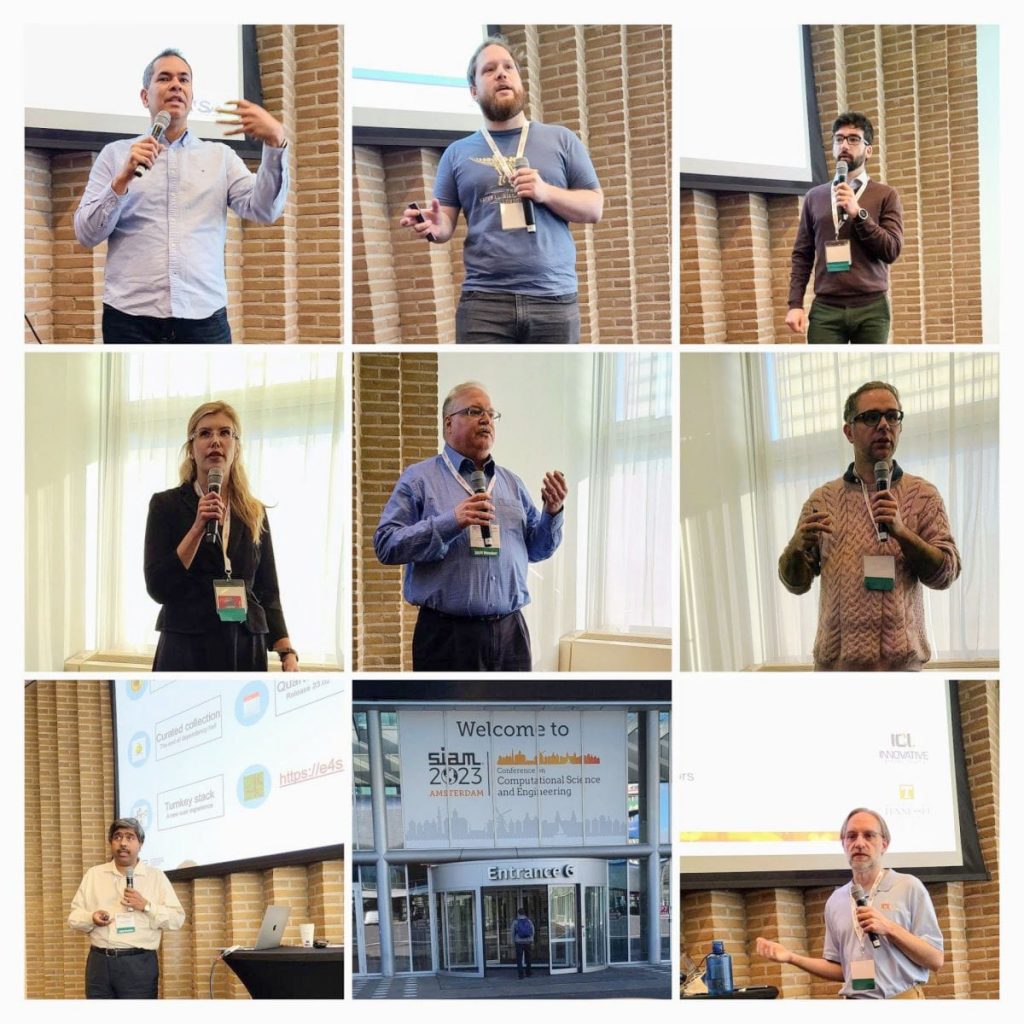
February 21, 2023: For those interested, please checkout a recently-submitted paper I co-authored with Eric Parish, Masa Yano and Traian Iliescu entitled "Residual-based stabilized reduced-order models of the transient convection-diffusion-reaction equation obtained through discrete and continuous projection". A pre-print is available for download from ArXiv.
February 13, 2023: A warm welcome to my new post doc, Chris Wentland, who recently completed his Ph.D. at the University of Michigan under Prof. Karthik Duraisamy! Chris will be splitting his time between two projects: (1) developing a novel alternating Schwarz-based method for the coupling of conventional and data-driven models, and (2) developing methods to enable attribution in climate under the CLDERA Grand Challenge LDRD project.
February 5, 2023: Excited to be partnering with University of New Mexico, University Texas of El Paso, New Mexico State University and Prairie View A&M University on a newly-funded NNSA Minority Serving Institution Partnership Program (MSIPP) project entitled Grande CARES. The project/consortium is described in the following article, for which I was interviewed/quoted.
January 28, 2023: Check out our paper, entitled "A Novel Partitioned Approach for Reduced Order Model—Finite Element Model (ROM-FEM) and ROM-ROM Coupling", which was recently published in the Proceedings of the 18th Biennial International Conference on Engineering, Science, Construction, and Operations in Challenging Environments.
January 3, 2023: After more than 1 year of waiting, our article entitled "A Novel In Situ Machine Learning Framework for Intelligent Data Capture and Event Detection" has been published in the Springer text "Machine Learning and Its Application to Reacting Flows". A PDF of the book can be downloaded here, for those interested.
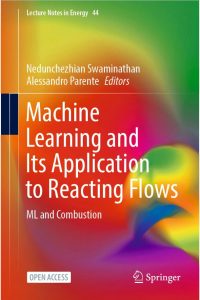
December 20, 2022: I found out today that I have been awarded a Simons Fellowship to visit the Isaac Newton Institute as part of “Mathematical & Statistical Foundation of Future Data-Driven Engineering” workshop held during winter/spring 2023.
December 5, 2022: I am excited to announce that I have been elected as Secretary of the SIAM Geosciences Activity Group and Vice Chair of the SIAM Mathematics of Planet Earth Activity Group for the upcoming 2023-2024 term. Thank you to everyone who voted for me!
November 8, 2022: I am honored to have been nominated to serve as Secretary of the SIAM Geosciences Activity Group and Vice Chair of the SIAM Mathematics of Planet Earth Activity Group. My bios/candidate statements can be found here and here, respectively. The elections are open from October 25 through November 29, 2022. Please vote, if you are a member of the relevant SIAM activity groups!
October 29, 2022: My student, Joshua Barnett, wrote a nice paper summarizing his work with me this past summer, a pre-print of which is available on ArXiv. The paper is entitled "The Schwarz alternating method for the seamless coupling of nonlinear reduced order models and full order models".
October 18, 2022: In Fall 2022, I participated in and help organize a set of workshops known as Artificial Intelligence for Earth System Programs (AI4ESP). The goal of the workshop was to discuss how Artificial Intelligence (AI) can enhance Earth system predictability across field, lab, modeling and analysis activities. The main takeaways from this workshop can be found in the just-released AI4ESP workshop report.
September 29, 2022: I am excited to share that our MMICC-3 project, entitled "M2dt: Multifaceted Mathematics for Predictive Digital Twins", for which I am the Sandia PI, was one of 4 selected for funding. More information can be found in the following press release: DOE Announces $56 Million for Research on Mathematical Multifaceted Integrated Capability Centers. A spreadsheet of the award recipients and their projects can be found here.
August 30, 2022: I am excited to share that our SciDAC-5 project, entitled "Framework for Antarctic System Science in E3SM (FAnSSIE)" was one of 7 selected for funding. More information can be found in the following press release: DOE Announces $70 Million to Improve Supercomputer Model of Earth’s Climate System.
August 16, 2022: I am excited to announce that our paper entitled "Global sensitivity analysis using the ultra-low resolution Energy Exascale Earth System Model" has been published online in the Journal of Advances in Modeling Earth Systems, and can be downloaded here. The paper presents results from the first-ever global sensitivity analysis using version 1 of the fully-coupled Energy Exascale Earth System Model (E3SM), and the first scientific study that utilized the ultra-low resolution configuration of this model.
July 13, 2022: As an Associate Editor of the IEEE Computing in Science & Engineering (CiSE) journal, I would like to publicize an open call just released for contributions to a special issue on the Future of Software Research Engineers in the U.S. Please feel free to contact me with any questions.
July 12, 2022: I am excited to share that our paper on improving accuracy of Least-Squares Petrov-Galerkin (LSPG) reduced order models through the introduction of preconditioning has been accepted for publication in IJNME and is available online here.
June 2022: The website for the CLDERA (CLimate impact: Determining Etiology thRough pAthways) Grand Challenge Laboratory Directed Research & Development Project, for which I am one of the leads, is live! The aim of CLDERA is to advance climate attribution science by identifying downstream impacts arising from geographically and temporally localized source forcings in the climate, thus distinguishing itself from traditional climate-change attribution that strives to identify impacts of long-term anthropogenic greenhouse gases. Please check out the website for more information and to access presentation/publications stemming from the project.
June 17, 2022: My intern, Max Carlson, was presented a Best Student Paper Award at the European Seminar on COmputing (ESCO) 2022. Below is a photo of Max receiving his award from Pavel Solin and Pavel Karban. Congratulations, Max!
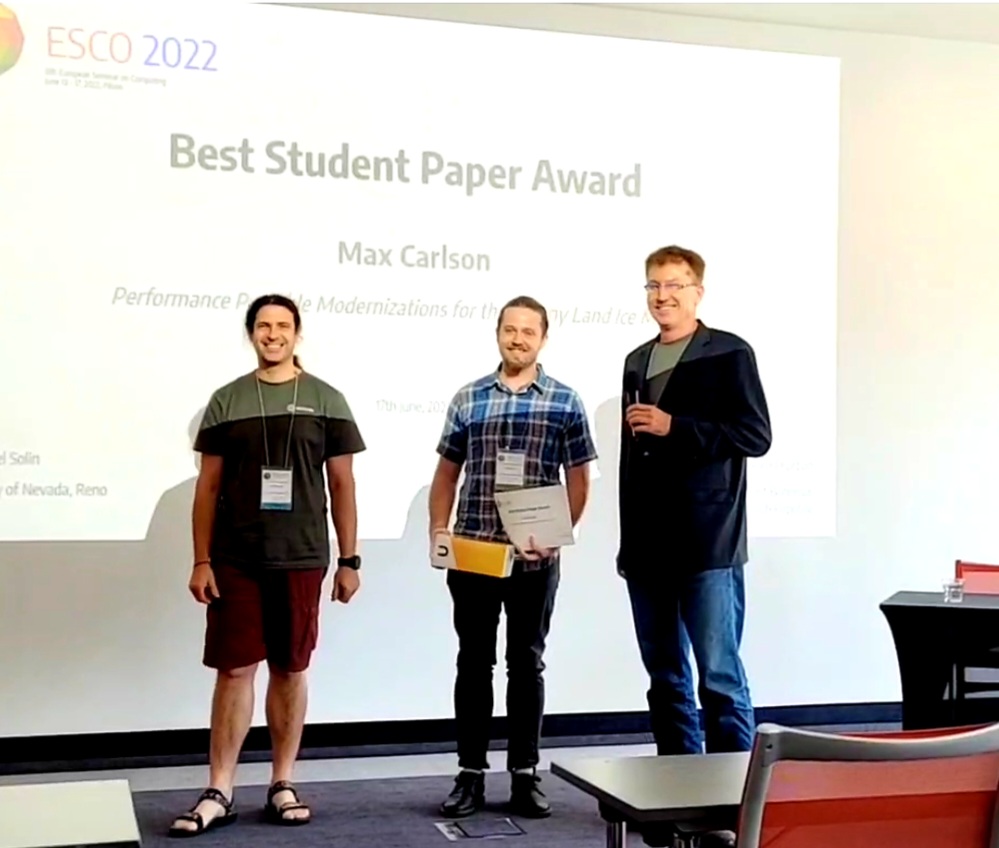
June 1, 2022: An article entitled “Large-scale PDE-constrained Optimization for Ice Sheet Model Initialization”, written by my colleague Mauro Perego on some of our land-ice modeling work, appeared in the SIAM News.
May 2022: A general audience article I was interviewed for / quoted in entitled "Scientists Recommend a Multidisciplinary Approach to Predicting Outbreaks" has been published in a special issue of One Health/One Planet.
April 2022: Our paper which develops the Schwarz alternating method as a means for concurrent multiscale coupling in transient dynamic multiscale solid mechanics problems has been accepted for publication in Int. J. Numer. Meth. Engng. and has been made available for download online.
April 2022: A pre-print of our paper on achieving performance portability of the MPAS-Albany Land Ice (MALI) model using the Kokkos library and programming model is available on ResearchGate and ArXiv.
March 2022: A pre-print of our recently-submitted paper on preconditioned Least-Squares Petrov-Galerkin (LSPG) Reduced Order Models (ROMs) is available on ArXiv. Our approach introduces a preconditioning matrix into the LSPG minimization problem, which can improve the residual-based stability constant bounding the ROM’s solution error by changing the norm defining the residual minimization. We demonstrate on several mechanical and thermo-mechanical problems that accuracy and efficiency can be improved by as much as 12x.
March 2022: ISML, a Python code I helped develop that enables in-situ, unsupervised anomaly/event detection on exascale platforms using a communication-minimizing workflow comprised of signatures, measures, and decisions, has been publicly released on github.
February 2022: I have been appointed Associate Editor of IEEE’s Computing in Science & Engineering Technical Magazine.
June 2021: A website for my project on Arctic coastal erosion modeling has been created and is live.
May 2021: Our paper on a novel thermo-mechanical model of permafrost/Arctic coastal erosion has just been published in ELSCAM.
May 2021: Check out the following Nature paper that came out on projected land ice contributions to twenty-first century sea level rise, made using land-ice models which include the MALI model I help to develop under the ProSPect project. The main takeaway is that sea level rise from the melting of polar ice sheets could be halved by 2100 if we meet the Paris Agreement target of limiting global warming to 1.5 degrees C. There are several general audience articles and news releases that discuss the results in the paper (King’s College of London News Centre, LANL News Release, NERSC Science News, The New York Times and The Washington Post).
April 2021: Earlier this year, the U.S. Department of Energy solicited white papers for the development and application of AI methods in areas relevant to the Earth and Environmental Systems Science Division (EESSD) of the office of Biological and Environmental Research (BER), with an emphasis on quantifying and improving Earth system predictability. The collection of white papers has been made available online here, for those interested. I was a coauthor on two white papers: "Climate Intervention Assessment and Attribution" and "Water Cycle-Driven Infectious Disease as Multiscale, Reliable, Continuosly Updating Water Cycle Sensors".
April 2021: Sandia National Labs’ 2020 HPC Annual Report has been released! Please check it out to get a sense of some of the cool R&D that is happening at Sandia in the area of computational science. There are two articles on my work, entitled "Advancing the Field of Reduced-Order Modeling" and "Pressio: an HPC Library to Enable Reduced-Order Modeling".
April 2021: On April 15, 2021, I gave a STEM Career Seminar at Casper College in which I shared some anecdotes from my life and described how they led to my pursuit of a career in computational science. To give students a perspective on my field and work, I also talked about what physics-based computational modeling and simulation is all about, and described what a typical day in the life of a computational scientist may be like. A video of the talk can be found here, for those who may be interested.
March 2021: Check out Sandia’s Laboratotry Directed Research and Development (LDRD) FY20 Annual Report, which discussed two projects I contributed to, "A predictive model of Arctic coastal erosion" and "Investing the Arctic tipping points triggering global change". Here is also a very nice video of my colleague Kara Peterson describing the latter project that accompanies the article in the report.
November 2020: A video of an ice sheet simulation performed using the MALI model, which I develop, as a part of the ISMIP6 submissions was featured in the Supercomputing 2020 Visualization & Data Analytics Challenge.
October 2020: I was one of 7 invited speakers at this year’s Pacific Northwest Numerical Analysis Seminar (PNWNAS), which took place virtually on Saturday, October 17, 2020.
Augustt 2020: Check out this nice description of the Scientific Visualization of E3SM’s Cryosphere Campaign Simulations featuring the MALI model, which I develop. The visualizations were produced by colleagues associated with the RAPIDS center.
May 2020: Some of my LDRD-funded work is highlighted in Sandia’s FY19 Lab Directed Research & Development (LDRD) Annual Report.
December 2019: An article about my meeting with Congressman Swalwell several weeks ago came out in the Sandia Lab News: "Congressman Swallwell visits Sandia/California".
November 2019: I had the opportunity to meet and discuss some of my R&D with Congressman Eric Swalwell (CA-15) during his visit to SNL/CA. Congressman Swalwell presented me with a Certificate of Special Congressional Recognition "in honor of being named an Honoree of the 2019 Presidential Early Career Award for Scientists & Engineers”. Below is a photo of me briefing Congressman Swalwell and Associate Lab Director Andy McIlroy on some of my work.
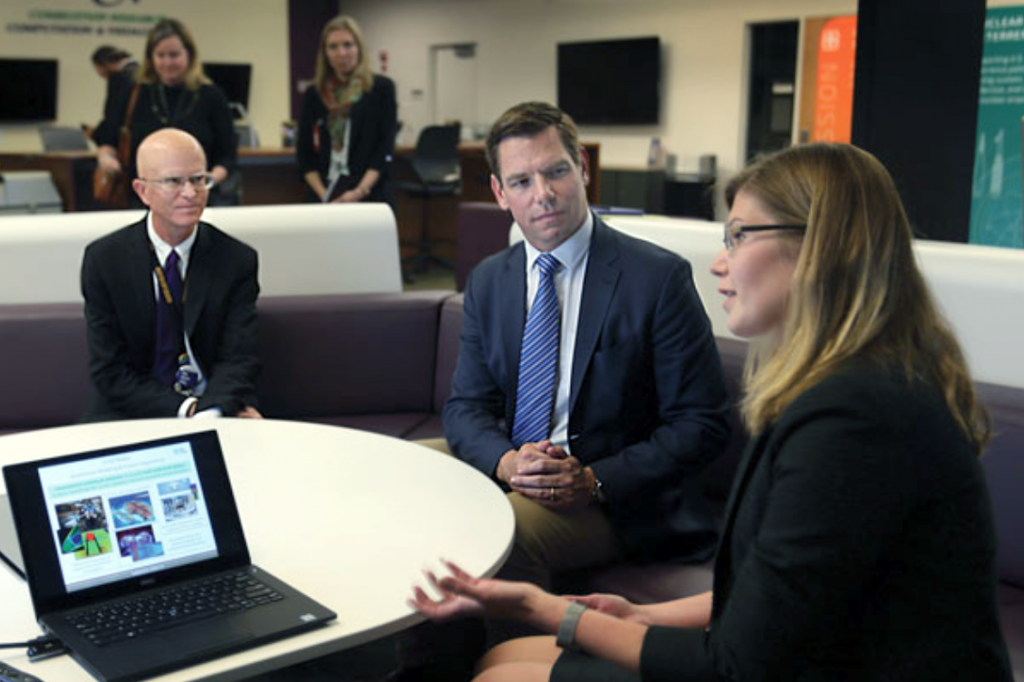
October 2019: An article about me came out in the Livermore Independent News: "From Moscow to Livermore: A Sandia Computer Scientist Tells of Her Compelling Journey".
September 2019: A general audience report entitled "Sandia in the Arctic: The Arctic Science and Security Initiative Report 2016-2019", which discusses R&D I have contributed to, came out.
August 2019: An article on my multi-scale coupling work with Alejandro Mota came out in the Aug. 29, 2019 Sandia Lab News/Sandia Press Release: "Getting to the nuts and bolts of the nuts and bolts".
July 2019: President Donald J. Trump issued a press release announcing that I am one of the recipients of the Presidential Early Career Award for Scientists and Engineers (PECASE) for “developing new, impactful mathematical methods and computer algorithms to enable real-time analysis, control, and decision-making on computationally prohibitive problems relevant to nuclear security mission and climate modeling.” Additional press releases have been issued by the NNSA, Sandia Lab News, SNL’s Center 8000, the ABQ journal, the Livermore Independent News, and the Secretary of Energy Rick Perry. Below are a few photos from the White House and DOE ceremonies, both of which took place in Washington D.C. on July 25.
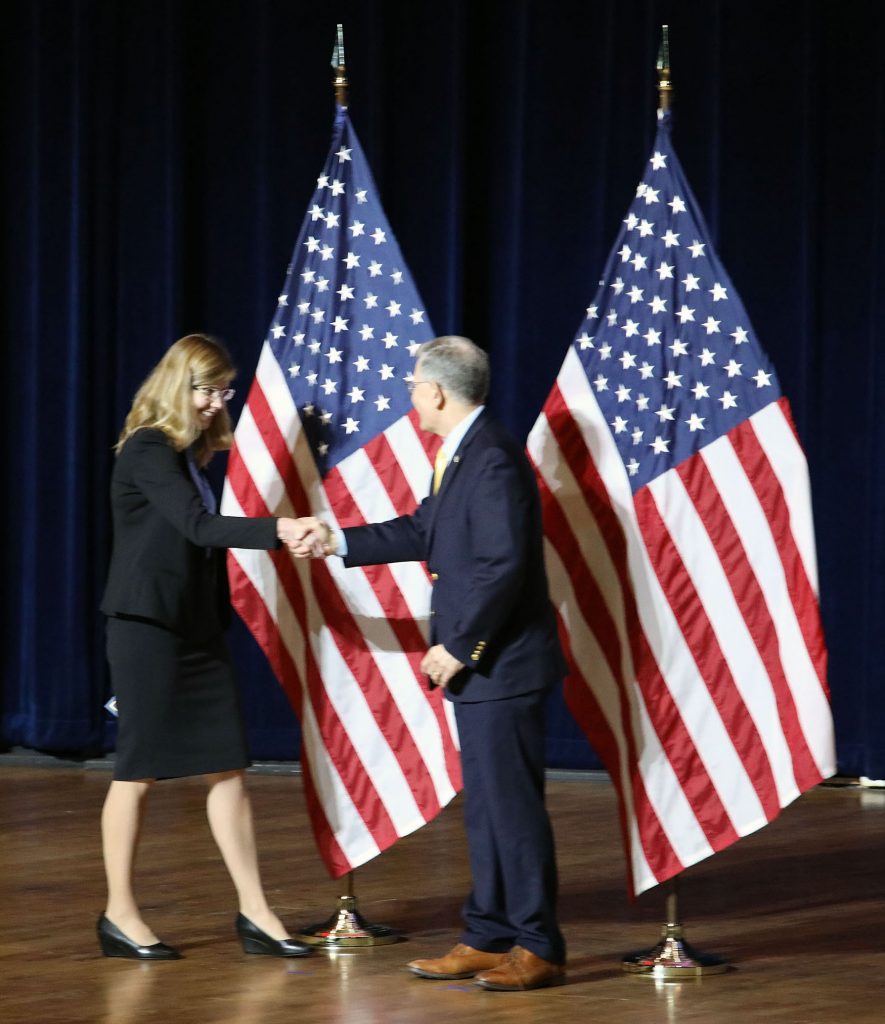
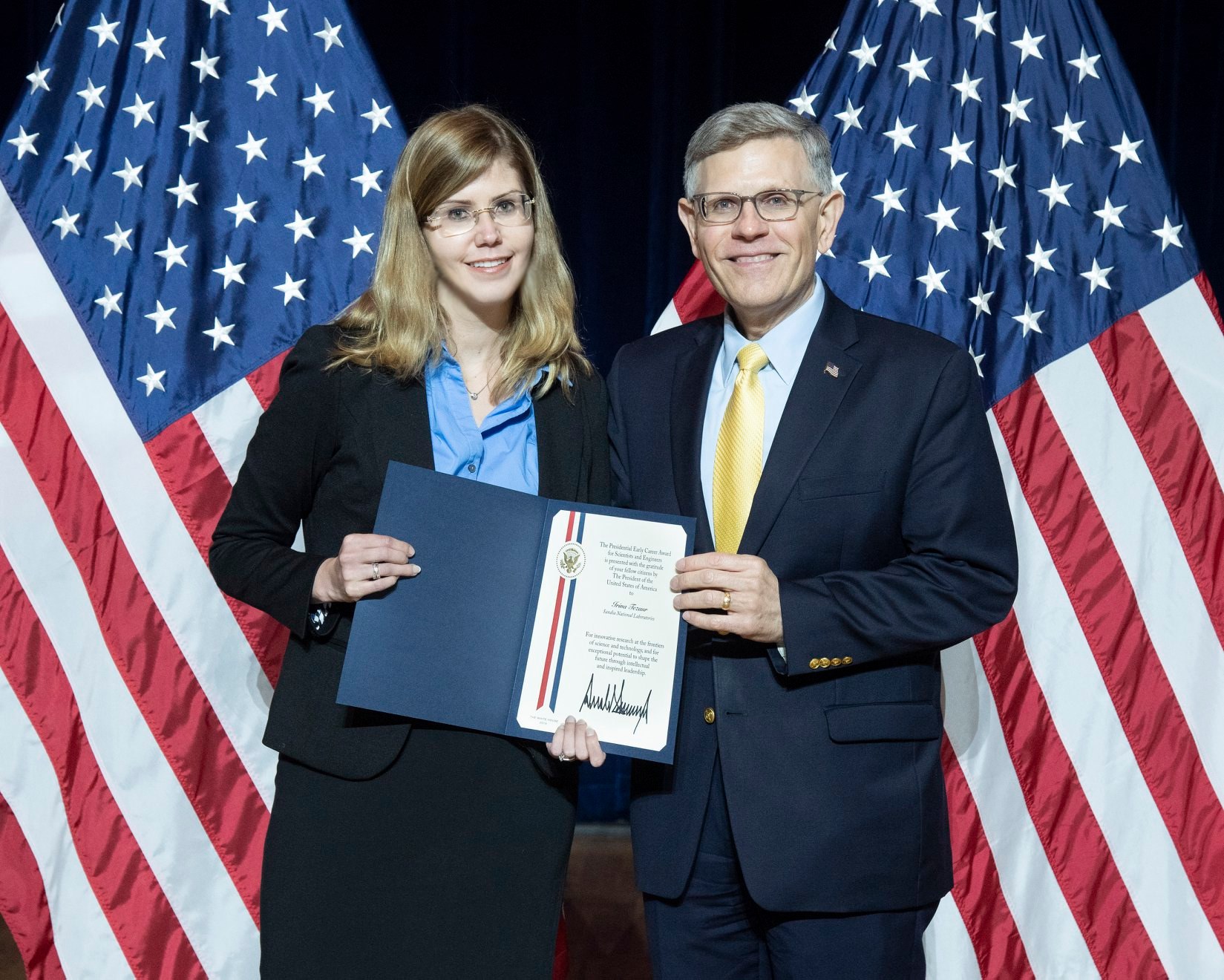
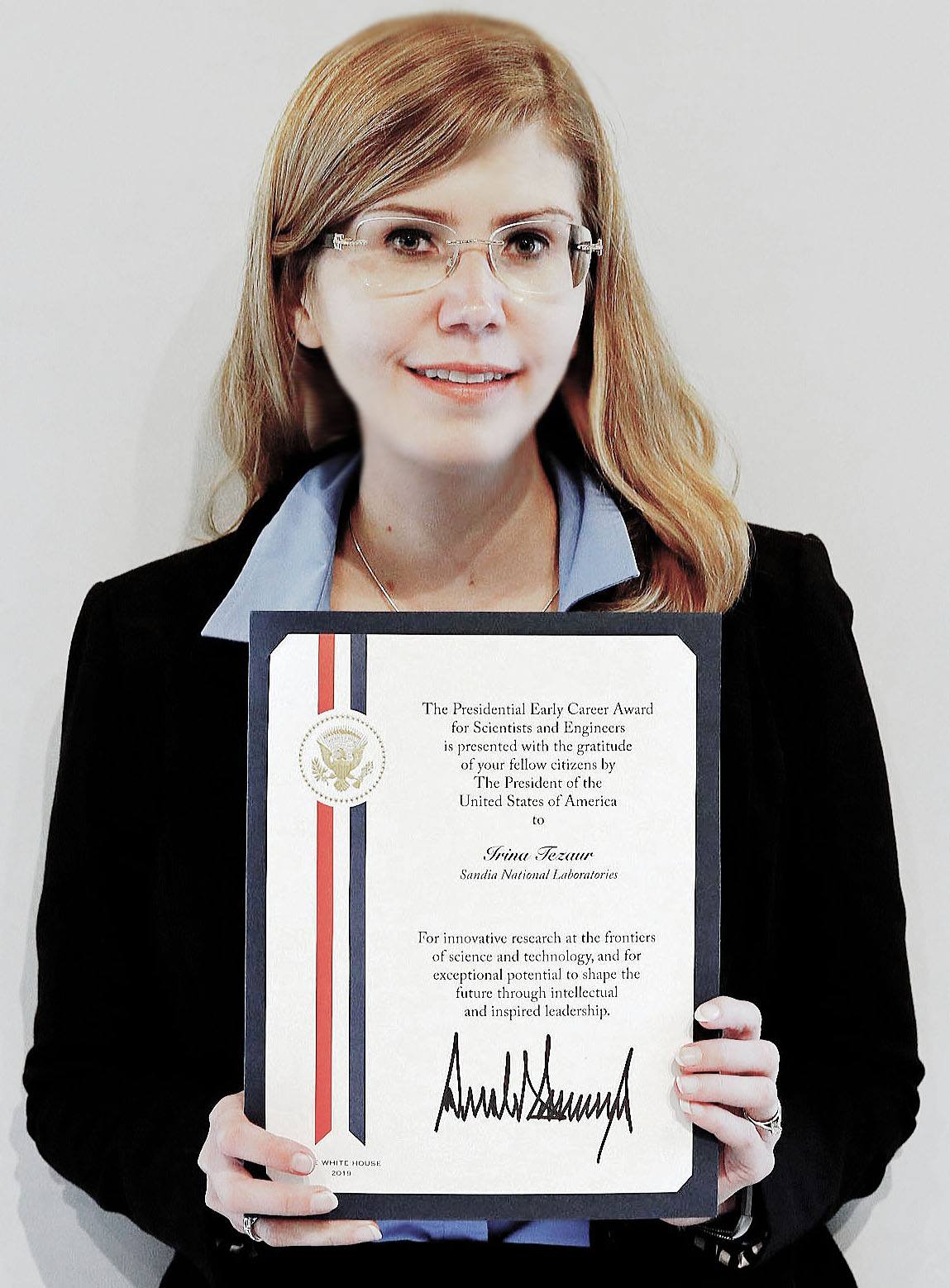
Receiving my PECASE award from Dr. Kelvin K. Drogemeier, Director of the White House Office of Science and Technology Policy during the White House ceremony on July 25, 2019.
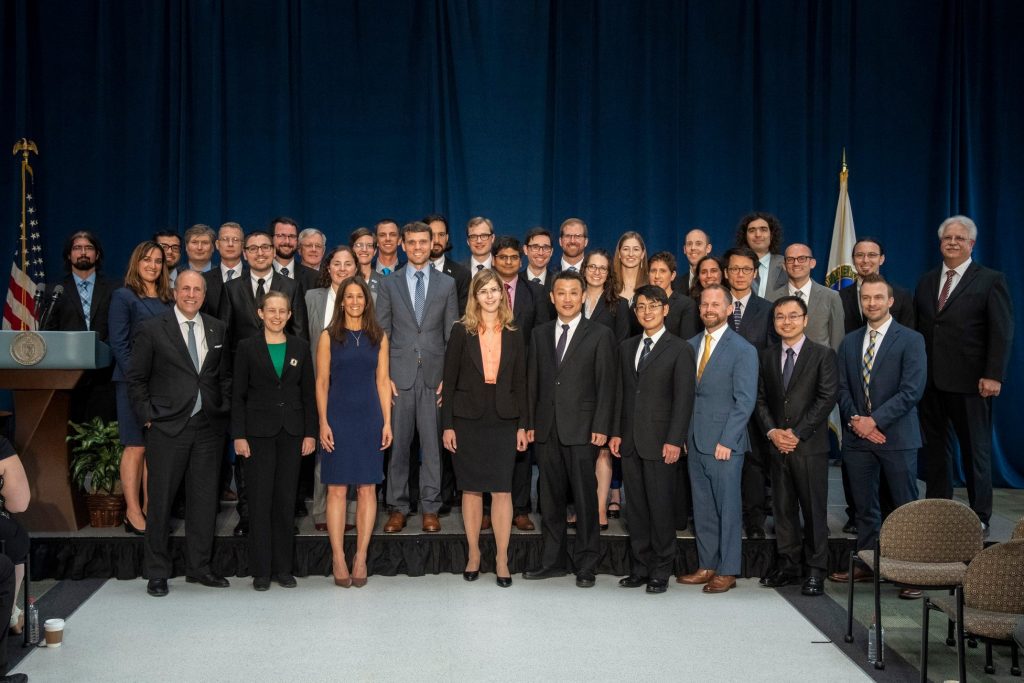
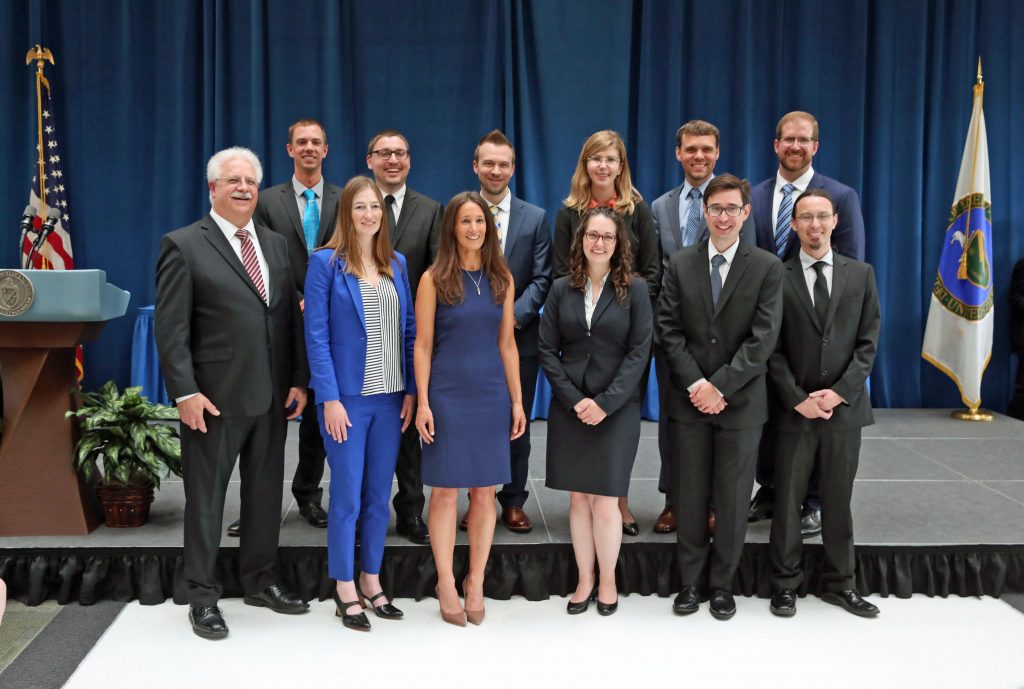
June 2019: The DOE Office of Science released a general-audience article on DOE Ice Sheet Modeling, which includes our contributions to the MPAS-Albany Land Ice (MALI) code.
September 2018: An article on our Schwarz multi-scale coupling work appeared in the Sandia National Laboratories High Performance Computing (HPC) Annual Report 2018: "Concurrent multiscale coupling in solid mechanics".
July 2018: A general audience article highlighting the importance of code verification in the context of climate was featured on the DOE Office of Science website: "How to Fit a Planet Inside a Computer: Developing the Energy Exascale Earth System Model". The bug discovered in the model leading the Earth to lose mass was discovered as part of the Climate Model Development & Validation (CMDV) project that I work on.
May 2017: Our land-ice modeling work performed under the PISCEES project was featured in the "Climate" section of the 2017 Sandia National Laboratories’ Labs Accomplishment report.
October 2016: SIAM news "nugget" article on our land-ice modeling work at Sandia was published: "Improving ice sheet models through algebraic multigrid methods".
August 2016: An article in Clean Technica that I was interviewed for on our land-ice modeling work at Sandia came out: "Forecasting, not fearing, sea-level rise".
April 2016: Out land-ice modeling work featured in "NNSA’s work and missions help save the earth".
March 2016: An article written by my colleague Kevin Carlberg on the West Coast ROM workshop held in Nov. 2015 where I was a speaker was published in the Mar. 1, 2016 issue of SIAM News: "Addressing Challenges in Reduced-Order Modeling".
February 2016: An article featuring my team’s land-ice modeling work entitled "Ice sheet modeling of Greenland, Antarctica helps predict sea-level rise" was published in a Feb. 5, 2016 Sandia Lab News/Sandia Press Release. The article was picked up by the following sources: Space Daily, PhysOrg, Scientific Computing, Eurasia Review, One News Page, Science Codex, Environmental News Network, Observatorio del Plastico, and the National Nuclear Security Administration (NNSA).
September 2015: An article on our land-ice modeling work appeared in the Sandia National Laboratories High Performance Computing (HPC) Annual Report 2015: "Rapid development of an ice sheet climate application using the components-based approach".
April 2008: I was awarded the Robert J. Melosh medal for the best student paper in finite element analysis.
Current Research and Software Projects
- Lead developer/product owner of the Albany and LCM open-source multi-physics codes.
- Developer/co-owner of Piro package in Trilinos.
- Co-developer of a novel Schwarz-like algorithm for simulating contact.
- Contributor to a BER-funded InteRFACE project focused on improving the understanding and computational modeling of coastal processes in Arctic.
- Contributor to a SciDAC project entitled Framework for Antarctic System Science in E3SM (FAnSSIE).
- Co-lead of a Sandia Grand Challenge LDRD project entitled "CLDERA – CLimate impact: Determining Etiology thRough pAthways".
- Co-PI of a Sandia LDRD project entitled "Rigorous and agile coupling of conventional and data-driven models for heterogeneous multi-physics, multi-scale simulations".
- Sandia PI of a DOE ASCR-funded MMICC-3 project entitled "M2dt: Multifaceted Mathematics for Predictive Digital Twins".
- Sandia PI of the National Nuclear Security Administration (NNSA) Minority Serving Institution Partnership Program (MSIPP) consortium entitled "The Rio Grande Consortium for Advanced Research on Exascale Simulation (Grande CARES)".
Past Research Projects
- Principal investigator of an internally-funded project on reduced order modeling (ROM) of compressible flow in captive-carry environments.
- Climate Model Development and Validation (CMDV) software project.
- Advanced Technology, Development, and Mitigation (ATDM) project on next-generation software and algorithm development.
- Developer of Tempus time-integration and sensitivity analysis package within Trilinos.
- Aeras next-generation atmosphere model LDRD project.
- Developer of the Schwarz alternating method for concurrent multiscale coupling for quasistatic and dynamic solid mechanics problems.
- Arctic Tipping Points LDRD project.
- Arctic coastal erosion (ACE) LDRD project aimed to deliver a field-validated predictive model of thermo-abrasive erosion for the permafrost Arctic coastline.
- Developer of XFEM (eXtended Finite Element Method) for Multi-Material Eulerian Solid/Hydrodynamics within the ALEGRA shock and multi-physics code.